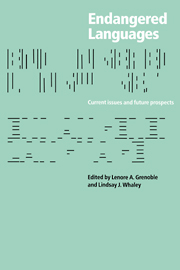Preface
Published online by Cambridge University Press: 05 June 2012
Summary
The imminent dawning of the next millennium offers an obvious, if somewhat arbitrary, inducement to evaluate the situation in which the world finds itself. There can be little doubt that a chief characteristic of our current state is extreme dynamism, perhaps most evident in the constant shifting of technology and material culture, but also plainly observable in everything from ecosystems to moral attitudes. In that small niche of the world which falls under the purview of linguists – language and language use – the globe as it now exists is also being transformed at an incredible rate. One particularly striking feature of this transformation is the number of languages which will simply cease to be spoken in the next fifty to a hundred years. The phenomenon of language death, and how various communities have responded and are responding to it, forms the theme of this volume.
It is generally agreed that there are somewhere between 5,000 and 6,000 languages spoken in the world today. These languages are unevenly distributed over the earth and over the world's population: while some countries, like Papua New Guinea, show extremely high language density (approximately 860 languages spoken in a territory of only 461,690 sq. km), other large areas may be characterized by relative scarcity. For example, there are but nine languages found in Saudia Arabia, six of which are varieties of Arabic, even though the country is over four times the size of Papua New Guinea.
- Type
- Chapter
- Information
- Endangered LanguagesLanguage Loss and Community Response, pp. vii - xviPublisher: Cambridge University PressPrint publication year: 1998
- 1
- Cited by



